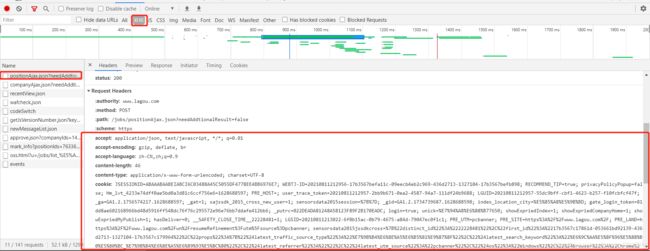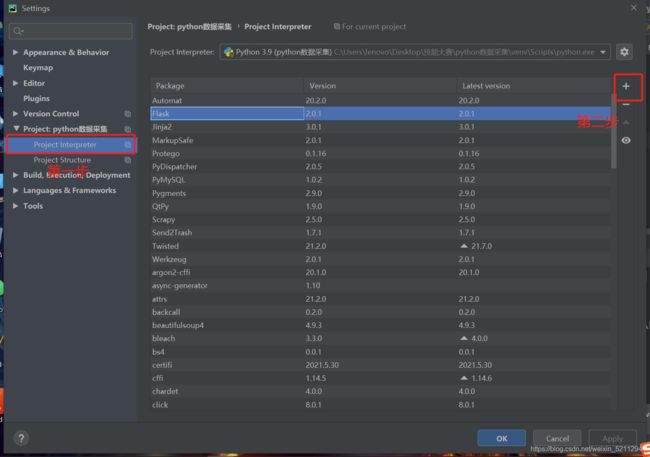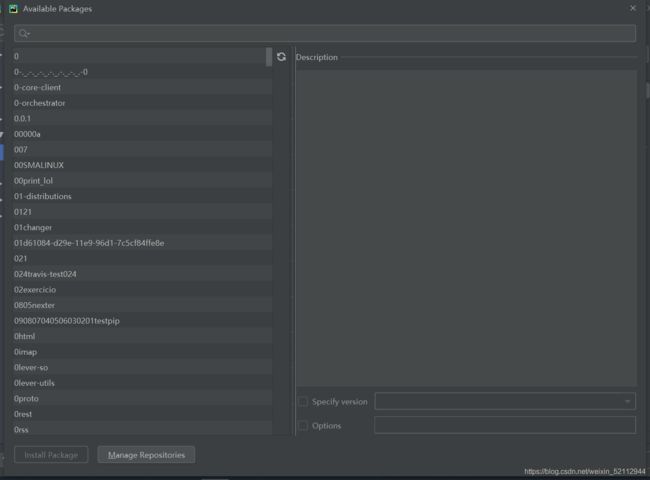python数据采集
python数据采集
- 一、采集豆瓣电影 Top 250的数据采集
-
- 1.进入豆瓣 Top 250的网页
- 2.进入开发者选项
- 3.进入top250中去查看相关配置
- 4.添加其第三方库
- 5.进行爬虫的编写
-
-
- 反反爬处理--伪装浏览器
-
- 6、bs4库中beautifulSoup类的使用
- 7、储存到CSV中
- 备注
- 二、安居客数据采集
-
- 1.安居客的网页
- 2.导入from lxml import etree
- 3.将采集的字符串转换为html格式:etree.html
- 4.转换后的数据调用xPath(xpath的路径):data.xpath(路径表达式)
- 三、拉勾网的数据采集
-
- (一)requests数据采集
-
- 1.导入库
- 2.向服务器发送请求
- 3.下载数据
- (二)post方式请求(参数不在url里)
-
- 1.通过网页解析找到post参数(请求数据Fromdata)并且参数定义到字典里
- 2.服务器发送请求调用requests.post(data=fromdata)
- (三)数据解析——json
-
- 1.导入 import——json
- 2. 将采集的json数据格式转换为python字典:json.load(json格式数据)
- 3.通过字典中的键访问值
- (四)数据存储到mysql中
-
- 1.下载并导入pymysql import pymysql
- 2.建立链接:conn=pymysql.Connenct(host,port,user,oassword,db,charset='utf8')
- 3.写sql语句
- 4.定义游标:cursor=conn.cursor()
- 5.使用定义的游标执行sql语句:cursor.execute()sql
- 6.向数据库提交数据:conn.commit()
- 7.关闭游标:cursor.close()
- 8.关闭链接:conn.close()
- 四、疫情数据采集
- 五、scrapy 数据采集
-
- (一)创建爬虫步骤
-
- 1.创建项目,在命令行输入:scrapy startproject 项目名称
- 2.创建爬虫文件:在命令行定位到spiders文件夹下:scrapy genspider 爬虫文件名 网站域名
- 3.运行程序:scrapy crawl 爬虫文件名
- (二)scrapy文件结构
-
- 1.spiders文件夹:编写解析程序
- 2.__init__.py:包标志文件,只有存在这个python文件的文件夹才是包
- 3.items.py:定义数据结构,用于定义爬取的字段
- 4.middlewares.py:中间件
- 5.pipliness.py:管道文件,用于定义数据存储方向
- 6.settings.py:配置文件,通常配置用户代理,管道文件开启。
- (三)scrapy爬虫框架使用流程
-
- 1.配置settings.py文件:
-
- (1)User-Agent:"浏览器参数"
- (2)ROBOTS协议:Fasle
- (3)修改ITEM_PIPLINES:打开管道
- 2.在item.py中定义爬取的字段
- 3.在spiders文件夹中的parse()方法中写解析代码并将解析结果提交给item对象
- 4.在piplines.py中定义存储路径
- 5.分页采集:
-
- 1)查找url的规律
- 2)在爬虫文件中先定义页面变量,使用if判断和字符串格式化方法生成新url
- 3)yield scrapy Requests(url,callback=parse)
- 案例
-
- (一)安居客数据采集
-
- 1.ajk.py中
- 2.pipelines.py中
- 3.items.py中
- 4.settings.py中
- 5.middlewares.py中
- (二)太平洋汽车数据采集
-
- 1.tpy.py中
- 2.pipelines.py中
- 3.items.py中
- 4.settings.py中
- 5.middlewares.py中
一、采集豆瓣电影 Top 250的数据采集
1.进入豆瓣 Top 250的网页
豆瓣电影 Top 250
2.进入开发者选项
3.进入top250中去查看相关配置
4.添加其第三方库
添加bs4、requests、lxml
5.进行爬虫的编写
(1)导入:import requests
(2)向服务器发送请求 requests=requests.get(url)
(3)获取网页数据:html =request.text
反反爬处理–伪装浏览器
1.定义变量geaders={用户代理}
2.向服务器发送请求时携带上代理信息:response=requests.get(url,headrs = h)
6、bs4库中beautifulSoup类的使用
1.导入:from bs4 import BeautifulSoup
2.定义soup对象:soup = BeautifulSoup(html,lxml)
3.使用soup对象调用类方法select(css选择器)
4.提取数据:
get_text()
text
string
7、储存到CSV中
1.先将数据存放到列表里
1.创建csv文档with open(‘xxx.csv’,‘a’,newlie=‘’) as f:
3.调用CSV模块中的write()方法:w=csv.write(f
4.将列表中的数据写入文档:w.writerows(listdata)
import requests,csv
from bs4 import BeautifulSoup
def getHtml(url):
# 数据采集
h ={
'User-Agent': 'Mozilla/5.0 (Windows NT 10.0; Win64; x64)'
}# 看下面的备注
response =requests.get(url,headers = h)
html=response.text
# print(html)
# 数据解析:正则,BeautifulSoup,Xpath
soup=BeautifulSoup(html,'lxml')
filmtitle =soup.select('div.hd > a > span:nth-child(1)')
ct=soup.select('div.bd > p:nth-child(1)')
score=soup.select(' div.bd > div > span.rating_num')
evalue =soup.select('div.bd > div > span:nth-child(4)')
# print(ct)
flimlist=[];
for t,c,s,e in zip(filmtitle,ct,score,evalue):
title = t.text
content= c.text
filmscore=s.text
num=e.text.strip('人评价')
director=content.strip().split()[1]
if "主演:" in content:
actor=content.strip().split('主演:')[1].split()[0]
else:
actor=None
year=content.strip().split('/')[-3].split()[-1]
area=content.strip().split('/')[-2].split()
filmtype=content.strip().split('/')[-1].split()
listdata=[title,director,actor,year,area,filmtype,num,filmscore]
flimlist.append(listdata)
print(flimlist)
# 存储数据
with open('douban250.csv','a',encoding='utf-8',newline="") as f:
w=csv.writer(f)
w.writerows(flimlist)
# 函数调用
with open('douban250.csv','a',encoding='utf-8',newline="") as f:
w=csv.writer(f)
listtitle=['title','director','actor','year','area','type','score','evealueate']
w.writerow(listtitle)
for i in range(0,226,25):
getHtml('https://movie.douban.com/top250?start=%s&filter='%(i))
备注
二、安居客数据采集
1.安居客的网页
安居客
2.导入from lxml import etree
3.将采集的字符串转换为html格式:etree.html
4.转换后的数据调用xPath(xpath的路径):data.xpath(路径表达式)
import requests
from lxml import etree
def getHtml(url):
h={
'user - agent': 'Mozilla / 5.0(Windows NT 10.0;Win64;x64)'
}
response = requests.get(url,headers=h)
html=response.text
# 数据解析
data=etree.HTML(html)
print(data)
name=data.xpath('//span[@class="items-name"]/text()')
print(name)
getHtml("https://bj.fang.anjuke.com/?from=AF_Home_switchcity")
三、拉勾网的数据采集
(一)requests数据采集
1.导入库
2.向服务器发送请求
3.下载数据
(二)post方式请求(参数不在url里)
1.通过网页解析找到post参数(请求数据Fromdata)并且参数定义到字典里
2.服务器发送请求调用requests.post(data=fromdata)
(三)数据解析——json
1.导入 import——json
2. 将采集的json数据格式转换为python字典:json.load(json格式数据)
3.通过字典中的键访问值
(四)数据存储到mysql中
1.下载并导入pymysql import pymysql
2.建立链接:conn=pymysql.Connenct(host,port,user,oassword,db,charset=‘utf8’)
3.写sql语句
4.定义游标:cursor=conn.cursor()
5.使用定义的游标执行sql语句:cursor.execute()sql
6.向数据库提交数据:conn.commit()
7.关闭游标:cursor.close()
8.关闭链接:conn.close()
这次的爬虫是需要账户的所以h是使用的Request Headers中的数据

import requests, json,csv,time,pymysql
keyword = input("请输入查询的职务")
def getHrml(url):
# 数据采集
h = {
'accept': 'application/json, text/javascript, */*; q=0.01',
'accept-encoding': 'gzip, deflate, br',
'accept-language': 'zh-CN,zh;q=0.9,en;q=0.8',
'content-length': '25',
'content-type': 'application/x-www-form-urlencoded; charset=UTF-8',
'cookie': 'JSESSIONID=ABAAAECABIEACCA0BB433B062238BA98562B2C4DC03D33A; WEBTJ-ID=20210713%E4%B8%8A%E5%8D%889:11:14091114-17a9d6b06f45b5-0f9ac091808606-6373264-1327104-17a9d6b06f531f; RECOMMEND_TIP=true; PRE_UTM=; PRE_LAND=https%3A%2F%2Fwww.lagou.com%2F; user_trace_token=20210713091113-ad1a1d99-8c61-4649-86de-caa60fecdd96; LGUID=20210713091113-57f6a01d-c07d-4d7d-a226-089ac21198e3; privacyPolicyPopup=false; sajssdk_2015_cross_new_user=1; sensorsdata2015session=%7B%7D; _ga=GA1.2.1716223378.1626138675; Hm_lvt_4233e74dff0ae5bd0a3d81c6ccf756e6=1626138675; LGSID=20210713091113-eef33caa-4fff-426f-a12f-d9ccdc49edab; PRE_HOST=www.baidu.com; PRE_SITE=https%3A%2F%2Fwww.baidu.com%2Flink%3Furl%3D1PmCn3%5F6suzwEKiV8mGzsySp2-ZqV4jK6AtxxnmDtde%26wd%3D%26eqid%3Dabee6e3e0030ff6d0000000360ece82b; _gid=GA1.2.1912526675.1626138675; index_location_city=%E5%85%A8%E5%9B%BD; hasDeliver=0; __lg_stoken__=a754529f8432345bce5a926838ce3ba208e2eb1b5e2aa7d40fdad449dd8fbc5fc68b31dd9e0579699a42fe25571f070de507bfb1ccd0d4cd334b58732e2966e98e41f591c3d3; gate_login_token=1a7455a0d75a2c4afa5e07a08311e9e93141da1f752d719873fcd5aadaffe363; LG_LOGIN_USER_ID=8ed9d2581d433f9543578454ebfed80f4ee5c5bee7be1dd4632f11fafed9de49; LG_HAS_LOGIN=1; _putrc=022DEADA81248A58123F89F2B170EADC; login=true; unick=%E7%94%A8%E6%88%B77650; showExpriedIndex=1; showExpriedCompanyHome=1; showExpriedMyPublish=1; __SAFETY_CLOSE_TIME__22228481=1; X_HTTP_TOKEN=3e22ba0cf8e3ba80701931626146c8e7a89d916f14; sensorsdata2015jssdkcross=%7B%22distinct_id%22%3A%2222228481%22%2C%22first_id%22%3A%2217a9d6b080a526-0c7af230c4b51d-6373264-1327104-17a9d6b080b931%22%2C%22props%22%3A%7B%22%24latest_traffic_source_type%22%3A%22%E7%9B%B4%E6%8E%A5%E6%B5%81%E9%87%8F%22%2C%22%24latest_search_keyword%22%3A%22%E6%9C%AA%E5%8F%96%E5%88%B0%E5%80%BC_%E7%9B%B4%E6%8E%A5%E6%89%93%E5%BC%80%22%2C%22%24latest_referrer%22%3A%22%22%2C%22%24os%22%3A%22Windows%22%2C%22%24browser%22%3A%22Chrome%22%2C%22%24browser_version%22%3A%2291.0.4472.124%22%2C%22lagou_company_id%22%3A%22%22%7D%2C%22%24device_id%22%3A%2217a9d6b080a526-0c7af230c4b51d-6373264-1327104-17a9d6b080b931%22%7D; Hm_lpvt_4233e74dff0ae5bd0a3d81c6ccf756e6=1626139109; TG-TRACK-CODE=search_code; LGRID=20210713091903-7c87ddc0-90c1-4e87-8970-4dbeefbb4c24; SEARCH_ID=2061158f47e14c7b87878919bbf28317',
'origin': 'https://www.lagou.com',
'referer': 'https://www.lagou.com/jobs/list_python?labelWords=&fromSearch=true&suginput=',
'sec-ch-ua': '"Not;A Brand";v="99", "Google Chrome";v="91", "Chromium";v="91"',
'sec-ch-ua-mobile': '?0',
'sec-fetch-dest': 'empty',
'sec-fetch-mode': 'cors',
'sec-fetch-site': 'same-origin',
'user-agent': 'Mozilla/5.0 (Windows NT 10.0; Win64; x64) AppleWebKit/537.36 (KHTML, like Gecko) Chrome/91.0.4472.124 Safari/537.36',
'x-anit-forge-code': '0',
'x-anit-forge-token': None,
'x-requested-with': 'XMLHttpRequest'
}
# 定义post方式参数
for num in range(1, 4):
fromdata = {
'first': 'true',
'pn': num,
'kd': keyword
}
# 向服务器发送请求
response = requests.post(url, headers=h, data=fromdata)
# 下载数据
joinhtml = response.text
# print(type(joinhtml))
# 解析数据
dictdata = json.loads(joinhtml)
# print(type(dictdata))
ct = dictdata['content']['positionResult']['result']
positonlist = []
for i in range(0, dictdata['content']['pageSize']):
positionName = ct[i]['positionName']
companyFullName = ct[i]['companyFullName']
city = ct[i]['city']
district = ct[i]['district']
companySize = ct[i]['companySize']
education = ct[i]['education']
salary = ct[i]['salary']
salaryMonth = ct[i]['salaryMonth']
workYear = ct[i]['workYear']
datalist=[positionName,companyFullName,city,district,companySize,education,salary,salaryMonth,workYear]
positonlist.append(datalist)
print(datalist)
# 建立链接
conn = pymysql.Connect(host='localhost', port=3306, user='root', passwd='lmy3.1415926', db='lagou',charset='utf8')
# sql
sql="insert into lg values('%s','%s','%s','%s','%s','%s','%s','%s','%s');"%(positionName,companyFullName,city,district,companySize,education,salary,salaryMonth,workYear)
# 创建游标并执行
cursor =conn.cursor()
try:
cursor.execute(sql)
conn.commit()
except:
conn.rollback()
cursor.close()
conn.close()
# 设置时间延迟
time.sleep(3)
with open('拉勾网%s职位信息.csv'%keyword,'a',encoding="utf-8",newline="") as f:
w=csv.writer(f)
w.writerows(positonlist)
# 调用函数
title=['职位名称','公司名称','公司所在城市','所属地区','公司人数','学历要求','薪资范围','薪资月','作年薪']
with open('拉勾网%s职位信息.csv'%keyword,'a',encoding="utf-8",newline="") as f:
w=csv.writer(f)
w.writerow(title)
getHrml('https://www.lagou.com/jobs/positionAjax.json?needAddtionalResult=false')
四、疫情数据采集
360疫情数据
import requests,json,csv,pymysql
def getHrml(url):
h={
'User-Agent': 'Mozilla/5.0 (Windows NT 10.0; Win64; x64) AppleWebKit/537.36 (KHTML, like Gecko) Chrome/91.0.4472.124 Safari/537.36'
}
response = requests.get(url, headers=h)
joinhtml = response.text
directro=joinhtml.split('(')[1]
directro2=directro[0:-2]
dictdata = json.loads(directro2)
ct = dictdata['country']
positonlist = []
for i in range(0, 196):
provinceName=ct[i]['provinceName']
cured=ct[i]['cured']
diagnosed=ct[i]['diagnosed']
died=ct[i]['died']
diffDiagnosed=ct[i]['diffDiagnosed']
datalist=[provinceName,cured,diagnosed,died,diffDiagnosed]
positonlist.append(datalist)
print(diagnosed)
conn = pymysql.Connect(host='localhost', port=3306, user='root', passwd='lmy3.1415926', db='lagou', charset='utf8')
sql = "insert into yq values('%s','%s','%s','%s','%s');" %(provinceName,cured,diagnosed,died,diffDiagnosed)
cursor = conn.cursor()
try:
cursor.execute(sql)
conn.commit()
except:
conn.rollback()
cursor.close()
conn.close()
with open('疫情数据.csv','a',encoding="utf-8",newline="") as f:
w=csv.writer(f)
w.writerows(positonlist)
title=['provinceName','cured','diagnosed','died','diffDiagnosed']
with open('疫情数据.csv','a',encoding="utf-8",newline="") as f:
w = csv.writer(f)
w.writerow(title)
getHrml('https://m.look.360.cn/events/feiyan?sv=&version=&market=&device=2&net=4&stype=&scene=&sub_scene=&refer_scene=&refer_subscene=&f=jsonp&location=true&sort=2&_=1626165806369&callback=jsonp2')
五、scrapy 数据采集
(一)创建爬虫步骤
1.创建项目,在命令行输入:scrapy startproject 项目名称
2.创建爬虫文件:在命令行定位到spiders文件夹下:scrapy genspider 爬虫文件名 网站域名
3.运行程序:scrapy crawl 爬虫文件名
(二)scrapy文件结构
1.spiders文件夹:编写解析程序
2.init.py:包标志文件,只有存在这个python文件的文件夹才是包
3.items.py:定义数据结构,用于定义爬取的字段
4.middlewares.py:中间件
5.pipliness.py:管道文件,用于定义数据存储方向
6.settings.py:配置文件,通常配置用户代理,管道文件开启。
(三)scrapy爬虫框架使用流程
1.配置settings.py文件:
(1)User-Agent:“浏览器参数”
(2)ROBOTS协议:Fasle
(3)修改ITEM_PIPLINES:打开管道
2.在item.py中定义爬取的字段
字段名 = scrapy.Field()
3.在spiders文件夹中的parse()方法中写解析代码并将解析结果提交给item对象
4.在piplines.py中定义存储路径
5.分页采集:
1)查找url的规律
2)在爬虫文件中先定义页面变量,使用if判断和字符串格式化方法生成新url
3)yield scrapy Requests(url,callback=parse)
案例
(一)安居客数据采集
其中的文件
1.ajk.py中
import scrapy
from anjuke.items import AnjukeItem
class AjkSpider(scrapy.Spider):
name = 'ajk'
#allowed_domains = ['bj.fang.anjuke.com/?from=navigation']
start_urls = ['https://bj.fang.anjuke.com/loupan/all/p1/']
pagenum = 1
def parse(self, response):
#print(response.text)
#response.encoding = 'gb2312'
item = AnjukeItem()
# 解析程序
name = response.xpath('//span[@class="items-name"]/text()').extract()
temp = response.xpath('//span[@class="list-map"]/text()').extract()
place = []
district = []
#print(temp)
for i in temp:
placetemp = "".join(i.split("]")[0].strip("[").strip().split())
districttemp = i.split("]")[1].strip()
#print(districttemp)
place.append(placetemp)
district.append(districttemp)
#apartment = response.xpath('//a[@class="huxing"]/span[not(@class)]/text()').extract()
area1 = response.xpath('//span[@class="building-area"]/text()').extract()
area = []
for j in area1:
areatemp = j.strip("建筑面积:").strip('㎡')
area.append(areatemp)
price = response.xpath('//p[@class="price"]/span/text()').extract()
# print(name)
# 将处理后的数据传入item中
item['name'] = name
item['place'] = place
item['district'] = district
#item['apartment'] = apartment
item['area'] = area
item['price'] = price
yield item
# print(type(item['name']))
for a,b,c,d,e in zip(item['name'],item['place'],item['district'],item['area'],item['price']):
print(a,b,c,d,e)
# 分页爬虫
if self.pagenum < 5:
self.pagenum += 1
newurl = "https://bj.fang.anjuke.com/loupan/all/p{}".format(str(self.pagenum))
#print(newurl)
yield scrapy.Request(newurl, callback=self.parse)
# print(type(dict(item)))
2.pipelines.py中
# Define your item pipelines here
#
# Don't forget to add your pipeline to the ITEM_PIPELINES setting
# See: https://docs.scrapy.org/en/latest/topics/item-pipeline.html
# useful for handling different item types with a single interface
from itemadapter import ItemAdapter
import csv,pymysql
# 存放到csv中
class AnjukePipeline:
def open_spider(self,spider):
self.f = open("安居客北京.csv", "w", encoding='utf-8', newline="")
self.w = csv.writer(self.f)
titlelist = ['name', 'place', 'distract', 'area', 'price']
self.w.writerow(titlelist)
def process_item(self, item, spider):
# writerow() [1,2,3,4] writerows() [[第一条记录],[第二条记录],[第三条记录]]
# 数据处理
k = list(dict(item).values())
self.listtemp = []
for a,b,c,d,e in zip(k[0],k[1],k[2],k[3],k[4]):
self.temp = [a,b,c,d,e]
self.listtemp.append(self.temp)
#print(listtemp)
self.w.writerows(self.listtemp)
return item
def close_spider(self,spider):
self.f.close()
# 存储到mysql中
class MySqlPipeline:
def open_spider(self,spider):
self.conn = pymysql.Connect(host="localhost",port=3306,user='root',password='lmy3.1415926',db="anjuke",charset='utf8')
def process_item(self,item,spider):
self.cursor = self.conn.cursor()
for a, b, c, d, e in zip(item['name'], item['place'], item['district'], item['area'], item['price']):
sql = 'insert into ajk values("%s","%s","%s","%s","%s");'%(a,b,c,d,e)
self.cursor.execute(sql)
self.conn.commit()
return item
def close_spider(self,spider):
self.cursor.close()
self.conn.close()
3.items.py中
# Define here the models for your scraped items
#
# See documentation in:
# https://docs.scrapy.org/en/latest/topics/items.html
import scrapy
class AnjukeItem(scrapy.Item):
# define the fields for your item here like:
name = scrapy.Field()
place = scrapy.Field()
district = scrapy.Field()
#apartment = scrapy.Field()
area = scrapy.Field()
price = scrapy.Field()
4.settings.py中
# Scrapy settings for anjuke project
#
# For simplicity, this file contains only settings considered important or
# commonly used. You can find more settings consulting the documentation:
#
# https://docs.scrapy.org/en/latest/topics/settings.html
# https://docs.scrapy.org/en/latest/topics/downloader-middleware.html
# https://docs.scrapy.org/en/latest/topics/spider-middleware.html
BOT_NAME = 'anjuke'
SPIDER_MODULES = ['anjuke.spiders']
NEWSPIDER_MODULE = 'anjuke.spiders'
# Crawl responsibly by identifying yourself (and your website) on the user-agent
USER_AGENT = 'Mozilla / 5.0(Windows NT 10.0;WOW64)'
# Obey robots.txt rules
ROBOTSTXT_OBEY = False
# Configure maximum concurrent requests performed by Scrapy (default: 16)
#CONCURRENT_REQUESTS = 32
# Configure a delay for requests for the same website (default: 0)
# See https://docs.scrapy.org/en/latest/topics/settings.html#download-delay
# See also autothrottle settings and docs
#DOWNLOAD_DELAY = 3
# The download delay setting will honor only one of:
#CONCURRENT_REQUESTS_PER_DOMAIN = 16
#CONCURRENT_REQUESTS_PER_IP = 16
# Disable cookies (enabled by default)
#COOKIES_ENABLED = False
# Disable Telnet Console (enabled by default)
#TELNETCONSOLE_ENABLED = False
# Override the default request headers:
#DEFAULT_REQUEST_HEADERS = {
# 'Accept': 'text/html,application/xhtml+xml,application/xml;q=0.9,*/*;q=0.8',
# 'Accept-Language': 'en',
#}
# Enable or disable spider middlewares
# See https://docs.scrapy.org/en/latest/topics/spider-middleware.html
#SPIDER_MIDDLEWARES = {
# 'anjuke.middlewares.AnjukeSpiderMiddleware': 543,
#}
# Enable or disable downloader middlewares
# See https://docs.scrapy.org/en/latest/topics/downloader-middleware.html
#DOWNLOADER_MIDDLEWARES = {
# 'anjuke.middlewares.AnjukeDownloaderMiddleware': 543,
#}
# Enable or disable extensions
# See https://docs.scrapy.org/en/latest/topics/extensions.html
#EXTENSIONS = {
# 'scrapy.extensions.telnet.TelnetConsole': None,
#}
# Configure item pipelines
# See https://docs.scrapy.org/en/latest/topics/item-pipeline.html
ITEM_PIPELINES = {
'anjuke.pipelines.AnjukePipeline': 300,
'anjuke.pipelines.MySqlPipeline': 301
}
# Enable and configure the AutoThrottle extension (disabled by default)
# See https://docs.scrapy.org/en/latest/topics/autothrottle.html
#AUTOTHROTTLE_ENABLED = True
# The initial download delay
#AUTOTHROTTLE_START_DELAY = 5
# The maximum download delay to be set in case of high latencies
#AUTOTHROTTLE_MAX_DELAY = 60
# The average number of requests Scrapy should be sending in parallel to
# each remote server
#AUTOTHROTTLE_TARGET_CONCURRENCY = 1.0
# Enable showing throttling stats for every response received:
#AUTOTHROTTLE_DEBUG = False
# Enable and configure HTTP caching (disabled by default)
# See https://docs.scrapy.org/en/latest/topics/downloader-middleware.html#httpcache-middleware-settings
#HTTPCACHE_ENABLED = True
#HTTPCACHE_EXPIRATION_SECS = 0
#HTTPCACHE_DIR = 'httpcache'
#HTTPCACHE_IGNORE_HTTP_CODES = []
#HTTPCACHE_STORAGE = 'scrapy.extensions.httpcache.FilesystemCacheStorage'
5.middlewares.py中
# Define here the models for your spider middleware
#
# See documentation in:
# https://docs.scrapy.org/en/latest/topics/spider-middleware.html
from scrapy import signals
# useful for handling different item types with a single interface
from itemadapter import is_item, ItemAdapter
class AnjukeSpiderMiddleware:
# Not all methods need to be defined. If a method is not defined,
# scrapy acts as if the spider middleware does not modify the
# passed objects.
@classmethod
def from_crawler(cls, crawler):
# This method is used by Scrapy to create your spiders.
s = cls()
crawler.signals.connect(s.spider_opened, signal=signals.spider_opened)
return s
def process_spider_input(self, response, spider):
# Called for each response that goes through the spider
# middleware and into the spider.
# Should return None or raise an exception.
return None
def process_spider_output(self, response, result, spider):
# Called with the results returned from the Spider, after
# it has processed the response.
# Must return an iterable of Request, or item objects.
for i in result:
yield i
def process_spider_exception(self, response, exception, spider):
# Called when a spider or process_spider_input() method
# (from other spider middleware) raises an exception.
# Should return either None or an iterable of Request or item objects.
pass
def process_start_requests(self, start_requests, spider):
# Called with the start requests of the spider, and works
# similarly to the process_spider_output() method, except
# that it doesn’t have a response associated.
# Must return only requests (not items).
for r in start_requests:
yield r
def spider_opened(self, spider):
spider.logger.info('Spider opened: %s' % spider.name)
class AnjukeDownloaderMiddleware:
# Not all methods need to be defined. If a method is not defined,
# scrapy acts as if the downloader middleware does not modify the
# passed objects.
@classmethod
def from_crawler(cls, crawler):
# This method is used by Scrapy to create your spiders.
s = cls()
crawler.signals.connect(s.spider_opened, signal=signals.spider_opened)
return s
def process_request(self, request, spider):
# Called for each request that goes through the downloader
# middleware.
# Must either:
# - return None: continue processing this request
# - or return a Response object
# - or return a Request object
# - or raise IgnoreRequest: process_exception() methods of
# installed downloader middleware will be called
return None
def process_response(self, request, response, spider):
# Called with the response returned from the downloader.
# Must either;
# - return a Response object
# - return a Request object
# - or raise IgnoreRequest
return response
def process_exception(self, request, exception, spider):
# Called when a download handler or a process_request()
# (from other downloader middleware) raises an exception.
# Must either:
# - return None: continue processing this exception
# - return a Response object: stops process_exception() chain
# - return a Request object: stops process_exception() chain
pass
def spider_opened(self, spider):
spider.logger.info('Spider opened: %s' % spider.name)
(二)太平洋汽车数据采集
1.tpy.py中
import scrapy
from taipy.items import TaipyItem
class TpySpider(scrapy.Spider):
name = 'tpy'
# allowed_domains = ['price.pcauto.com.cn/top/k0-p1.html']
start_urls = ['https://price.pcauto.com.cn/top/k0-p1.html']
pagenum = 1
def parse(self, response):
item = TaipyItem()
# response.encoding ='gb2312'
# print(response.text)
name = response.xpath('//p[@class="sname"]/a/text()').extract()
temperature = response.xpath('//p[@class="col rank"]/span[@class="fl red rd-mark"]/text()').extract()
price = response.xpath('//p/em[@class="red"]/text()').extract()
brand2 = response.xpath('//p[@class="col col1"]/text()').extract()
brand = []
for j in brand2:
areatemp = j.strip('品牌:').strip('排量:').strip('\r\n')
brand.append(areatemp)
brand = [i for i in brand if i != '']
rank2 = response.xpath('//p[@class="col"]/text()').extract()
rank = []
for j in rank2:
areatemp = j.strip('级别:').strip('变速箱:').strip('\r\n')
rank.append(areatemp)
rank = [i for i in rank if i != '']
item['name'] = name
item['temperature'] = temperature
item['price'] = price
item['brand'] = brand
item['rank'] = rank
yield item
for a, b, c, d, e in zip(item['name'], item['temperature'], item['price'], item['brand'], item['rank']):
print(a, b, c, d, e)
if self.pagenum < 6:
self.pagenum += 1
newurl = "https://price.pcauto.com.cn/top/k0-p{}.html".format(str(self.pagenum))
print(newurl)
yield scrapy.Request(newurl, callback=self.parse)
#print(type(dict(item)))
2.pipelines.py中
# Define your item pipelines here
#
# Don't forget to add your pipeline to the ITEM_PIPELINES setting
# See: https://docs.scrapy.org/en/latest/topics/item-pipeline.html
# useful for handling different item types with a single interface
from itemadapter import ItemAdapter
import csv,pymysql
class TaipyPipeline:
def open_spider(self, spider):
self.f=open("太平洋.csv", "w", encoding='utf-8', newline="")
self.w = csv.writer(self.f)
titlelist=['name','temperature','price','brand','rank']
self.w.writerow(titlelist)
def process_item(self, item, spider):
k = list(dict(item).values())
self.listtemp = []
for a, b, c, d, e in zip(k[0], k[1], k[2], k[3], k[4]):
self.temp = [a, b, c, d, e]
self.listtemp.append(self.temp)
print(self.listtemp)
self.w.writerows(self.listtemp)
return item
def close_spider(self, spider):
self.f.close()
class MySqlPipeline:
def open_spider(self,spider):
self.conn = pymysql.Connect(host="localhost",port=3306,user='root',password='lmy3.1415926',db="taipy",charset='utf8')
def process_item(self,item,spider):
self.cursor = self.conn.cursor()
for a, b, c, d, e in zip(item['name'], item['temperature'], item['price'], item['brand'], item['rank']):
sql = 'insert into tpy values("%s","%s","%s","%s","%s");'%(a,b,c,d,e)
self.cursor.execute(sql)
self.conn.commit()
return item
def close_spider(self,spider):
self.cursor.close()
self.conn.close()
3.items.py中
# Define here the models for your scraped items
#
# See documentation in:
# https://docs.scrapy.org/en/latest/topics/items.html
import scrapy
class TaipyItem(scrapy.Item):
# define the fields for your item here like:
name = scrapy.Field()
temperature = scrapy.Field()
price = scrapy.Field()
brand = scrapy.Field()
rank = scrapy.Field()
4.settings.py中
# Scrapy settings for taipy project
#
# For simplicity, this file contains only settings considered important or
# commonly used. You can find more settings consulting the documentation:
#
# https://docs.scrapy.org/en/latest/topics/settings.html
# https://docs.scrapy.org/en/latest/topics/downloader-middleware.html
# https://docs.scrapy.org/en/latest/topics/spider-middleware.html
BOT_NAME = 'taipy'
SPIDER_MODULES = ['taipy.spiders']
NEWSPIDER_MODULE = 'taipy.spiders'
# Crawl responsibly by identifying yourself (and your website) on the user-agent
USER_AGENT = 'Mozilla/5.0 (Windows NT 10.0; Win64; x64)'
# Obey robots.txt rules
ROBOTSTXT_OBEY = False
# Configure maximum concurrent requests performed by Scrapy (default: 16)
#CONCURRENT_REQUESTS = 32
# Configure a delay for requests for the same website (default: 0)
# See https://docs.scrapy.org/en/latest/topics/settings.html#download-delay
# See also autothrottle settings and docs
#DOWNLOAD_DELAY = 3
# The download delay setting will honor only one of:
#CONCURRENT_REQUESTS_PER_DOMAIN = 16
#CONCURRENT_REQUESTS_PER_IP = 16
# Disable cookies (enabled by default)
#COOKIES_ENABLED = False
# Disable Telnet Console (enabled by default)
#TELNETCONSOLE_ENABLED = False
# Override the default request headers:
#DEFAULT_REQUEST_HEADERS = {
# 'Accept': 'text/html,application/xhtml+xml,application/xml;q=0.9,*/*;q=0.8',
# 'Accept-Language': 'en',
#}
# Enable or disable spider middlewares
# See https://docs.scrapy.org/en/latest/topics/spider-middleware.html
#SPIDER_MIDDLEWARES = {
# 'taipy.middlewares.TaipySpiderMiddleware': 543,
#}
# Enable or disable downloader middlewares
# See https://docs.scrapy.org/en/latest/topics/downloader-middleware.html
#DOWNLOADER_MIDDLEWARES = {
# 'taipy.middlewares.TaipyDownloaderMiddleware': 543,
#}
# Enable or disable extensions
# See https://docs.scrapy.org/en/latest/topics/extensions.html
# EXTENSIONS = {
# # 'taipy.pipelines.TaipyItem':300
# }
# Configure item pipelines
# See https://docs.scrapy.org/en/latest/topics/item-pipeline.html
ITEM_PIPELINES = {
'taipy.pipelines.TaipyPipeline': 300,
'taipy.pipelines.MySqlPipeline':301
}
# Enable and configure the AutoThrottle extension (disabled by default)
# See https://docs.scrapy.org/en/latest/topics/autothrottle.html
#AUTOTHROTTLE_ENABLED = True
# The initial download delay
#AUTOTHROTTLE_START_DELAY = 5
# The maximum download delay to be set in case of high latencies
#AUTOTHROTTLE_MAX_DELAY = 60
# The average number of requests Scrapy should be sending in parallel to
# each remote server
#AUTOTHROTTLE_TARGET_CONCURRENCY = 1.0
# Enable showing throttling stats for every response received:
#AUTOTHROTTLE_DEBUG = False
# Enable and configure HTTP caching (disabled by default)
# See https://docs.scrapy.org/en/latest/topics/downloader-middleware.html#httpcache-middleware-settings
#HTTPCACHE_ENABLED = True
#HTTPCACHE_EXPIRATION_SECS = 0
#HTTPCACHE_DIR = 'httpcache'
#HTTPCACHE_IGNORE_HTTP_CODES = []
#HTTPCACHE_STORAGE = 'scrapy.extensions.httpcache.FilesystemCacheStorage'
5.middlewares.py中
# Define here the models for your spider middleware
#
# See documentation in:
# https://docs.scrapy.org/en/latest/topics/spider-middleware.html
from scrapy import signals
# useful for handling different item types with a single interface
from itemadapter import is_item, ItemAdapter
class TaipySpiderMiddleware:
# Not all methods need to be defined. If a method is not defined,
# scrapy acts as if the spider middleware does not modify the
# passed objects.
@classmethod
def from_crawler(cls, crawler):
# This method is used by Scrapy to create your spiders.
s = cls()
crawler.signals.connect(s.spider_opened, signal=signals.spider_opened)
return s
def process_spider_input(self, response, spider):
# Called for each response that goes through the spider
# middleware and into the spider.
# Should return None or raise an exception.
return None
def process_spider_output(self, response, result, spider):
# Called with the results returned from the Spider, after
# it has processed the response.
# Must return an iterable of Request, or item objects.
for i in result:
yield i
def process_spider_exception(self, response, exception, spider):
# Called when a spider or process_spider_input() method
# (from other spider middleware) raises an exception.
# Should return either None or an iterable of Request or item objects.
pass
def process_start_requests(self, start_requests, spider):
# Called with the start requests of the spider, and works
# similarly to the process_spider_output() method, except
# that it doesn’t have a response associated.
# Must return only requests (not items).
for r in start_requests:
yield r
def spider_opened(self, spider):
spider.logger.info('Spider opened: %s' % spider.name)
class TaipyDownloaderMiddleware:
# Not all methods need to be defined. If a method is not defined,
# scrapy acts as if the downloader middleware does not modify the
# passed objects.
@classmethod
def from_crawler(cls, crawler):
# This method is used by Scrapy to create your spiders.
s = cls()
crawler.signals.connect(s.spider_opened, signal=signals.spider_opened)
return s
def process_request(self, request, spider):
# Called for each request that goes through the downloader
# middleware.
# Must either:
# - return None: continue processing this request
# - or return a Response object
# - or return a Request object
# - or raise IgnoreRequest: process_exception() methods of
# installed downloader middleware will be called
return None
def process_response(self, request, response, spider):
# Called with the response returned from the downloader.
# Must either;
# - return a Response object
# - return a Request object
# - or raise IgnoreRequest
return response
def process_exception(self, request, exception, spider):
# Called when a download handler or a process_request()
# (from other downloader middleware) raises an exception.
# Must either:
# - return None: continue processing this exception
# - return a Response object: stops process_exception() chain
# - return a Request object: stops process_exception() chain
pass
def spider_opened(self, spider):
spider.logger.info('Spider opened: %s' % spider.name)





